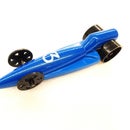Introduction: Acrylic Gravity Powered Clock
We made a gravity-powered, acrylic clock with a minute and hour hand. This is achieved by utilizing two heavy weights and a pendulum that allows the clock to “tick” once a second. The pendulum must not slow down or else the clock would stop moving, so in order to keep the clock in perpetual motion, a mechanism called an escapement is used to “nudge” the pendulum as it swings to keep it in motion. The force behind this “nudge” comes from the hanging mass, which converts its gravitational force into rotational torque that powers the escapement. The pendulum’s oscillation is then converted into rotational speed that moves a gear train at the new, precise speed created by the escapement. Once the gear achieves one rotation per sixty minutes, a rod attached to the gear’s center carries the rotation to the minute hand of the clock. Then, gears interlocking with the minute hand convert the rotational speed from one rotation every hour, to one rotation every twelve hours, giving us the correct timing for the hour hand. A cylindrical, brass sleeve is placed around the rod attached to the minute hand, which allows the hour hand to rotate independently of the minute hand, while still on the same axis. The frame of the clock is made of wood that was cut using a CNC machine, the more complex parts were 3D printed, and all of the gears were laser cut from acrylic sheets. Once all of the parts were modeled on solidworks and an assembly was made, all the parts were produced and assembled in the shop.
Step 1: Obtain Materials and Supplies
-SolidWorks 3D Modeling Program
-Acrylic Sheets
-3D Printer
-Wood
-CNC Machine
-Laser Cutter
-6mm Steel Rods
-7.9mm Brass Sleeves
-Weighted Mass to Hang from a String
-String
-Pendulum Bob
Step 2: 3D Model All Parts on SolidWorks
All parts can be created through a 3D modeling .
Gears can be simply created with just dimensions of the tooth and a revolve. Following the revolve you will need to extrude the gears to 10mm. Don't forget to start in MM or you will have to restart the whole process as you cannot change unit of measure while creating a part.
Other parts are basic and can be followed on the schematics provided.
Step 3: Convert SolidWorks Parts Into Formats That Work With the 3D Printer, Laser Cutter, and CNC Machine
Save the solidworks files as .STL files for 3D printing and Adobe Illustrator for laser cutting. For the CNC machine, convert the files to an .SBP file.
Step 4: Laser Cut Gears From the Acrylic Sheets and Cut the Frame Using the CNC Machine
Using the Adobe illustrator files upload them to the laser cutter and cut out the required parts. Cut out using thin layers of acrylic. Upload the SBP files into the CNC machine and cut the 3 frame pieces from wood slabs.
Step 5: 3D Print Any Parts That Cannot Be Cut
Import the STL file of the SolidWorks part into the 3D Printer. Print all other parts that have not yet been CNC cut or laser cut and then you are ready for assembly.
Step 6: Assemble the Printed and Cut Parts, Sanding and Polishing As Necessary
After printing or cutting all parts of the clock follow the instruction on the main page and assemble the clock to the exact specification.
Step 7: Calibrate the Weight to Suit the Clock As Needed
Once the clock has been assembled you must calibrate the hanging weight to the correct mass so that the clock rotates at the correct speed to tell correct time. To little weight moves the clock pendulum stops swinging, and to much weight could break the clock.
Step 8: Stand Back and Appreciate Clock
Once you are done you should get this warm feeling in your fingertips and a smile should break across your face. You just completed a work of art. Enjoy :)













